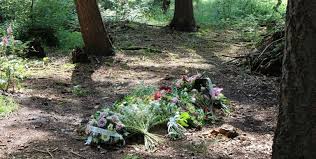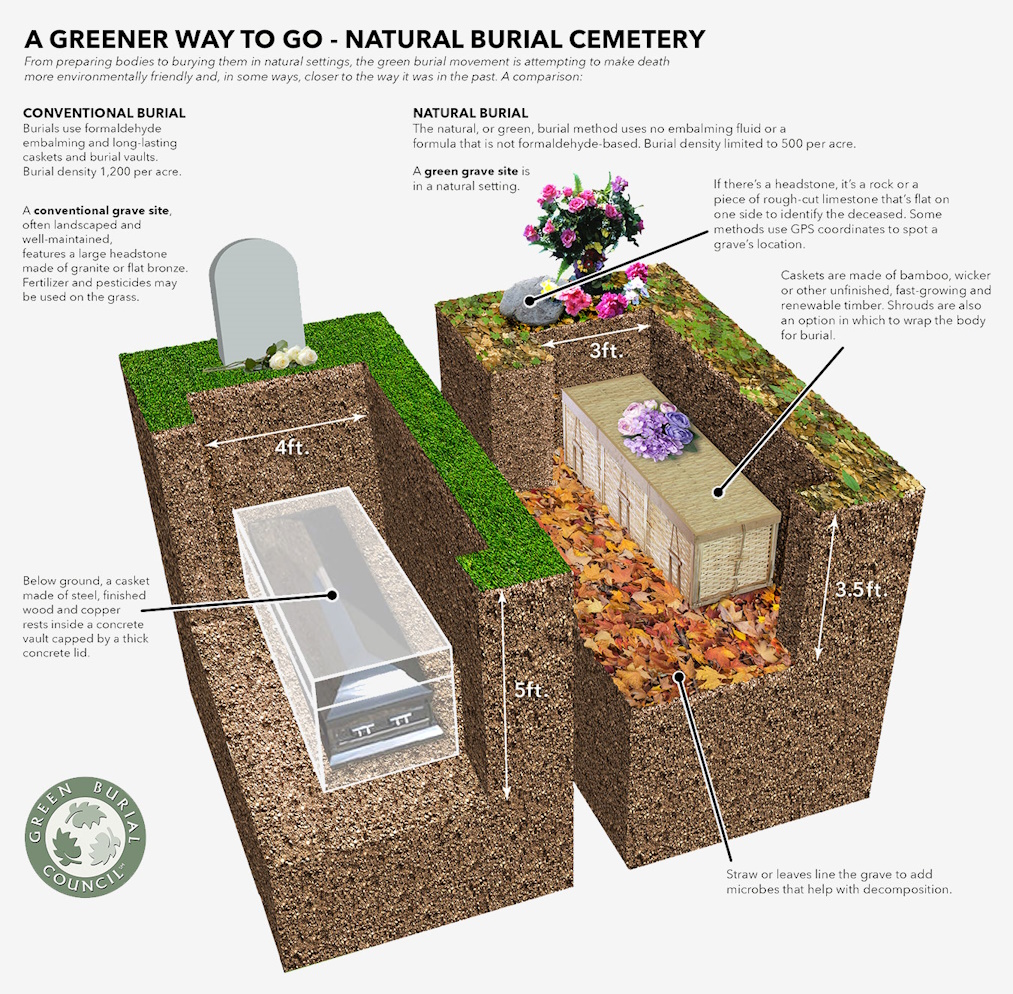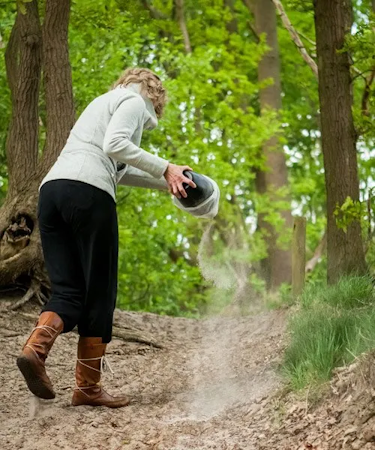|
On
this Page
Introduction
|
This
page is dedicated to exploring more
sustainable and environmentally friendly
methods of handling death and the
afterlife.
Here, we'll delve into innovative
methods of disposition and all things
“greening death” that align
with the modern pan-death movement's
commitment to ecological sustainability.
Before
delving into the various options available
for eco-friendly disposition, it's
important to understand the terminology
and definitions. So, let's
start with that. |
|
Mary's grave — her body shrouded and surrounded by cedar — is at the Woodlands, Royal Oak Burial Park in Victoria British Columbia |

Conventional Terminology Used on this Page
| |
Disposition
— Refers to the final handling
of the body after death. It includes
various methods of body disposal, such
as burial, cremation, donation to science,
and other alternatives. The disposition
of a dead body is often subject to legal
regulations and personal or cultural
beliefs and traditions. It is
an important aspect of the funeral and
mourning process and can have significant
emotional, spiritual, and practical
implications for the deceased person's
loved ones. |
| |
Conventional
Burial — A funeral practice
in which the deceased's body is prepared
and placed in a casket, which is then
buried in a cemetery. This approach
typically involves embalming the body
with chemicals to delay decomposition,
placing the casket in a concrete vault
to prevent the ground from settling,
and using a headstone or marker to mark
the grave. Conventional burials are
often associated with the funeral industry
and can be expensive and resource-intensive. |
| |
Cremation
— Cremation is the process of reducing
a body to ashes through high-temperature
combustion. |
| |
Embalming
— Embalming is the process of preserving
a deceased body by using chemicals to
delay decomposition. |

Disposition
WHAT
DO WE CURRENTLY DO?
| When
someone dies, burial and cremation are
the two most commonly used methods of
disposition. While conventional
funerals and burials can have a negative
impact on the environment by using embalming
fluid, steel, concrete, and rare tropical
hardwood, it's important to note that
there are no wrong choices when it comes
to handling death and disposition. It's
crucial to recognize and respect the
cultural traditions of different communities
and work towards finding solutions that
are both culturally appropriate and
ecologically sustainable. |
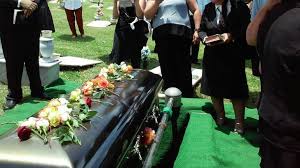 metal casket
on artificial turf
metal casket
on artificial turf |
|
Courtesy
of the Green Burial Council
|
In
Canada, cremation is a popular disposition
choice; but it is the least eco-friendly
solution, since it requires large amounts
of fossil fuel and emits greenhouse
gases (GhGs) and heavy metals. Despite
this, Canadian cremation rates continue
to rise and are expected to reach almost
78 percent by 2024.
In light of these environmental concerns,
it's essential to explore alternative
options that allow bodies to return
to the earth naturally. |
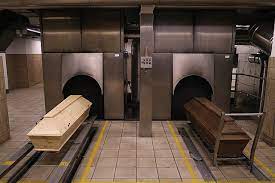 cremation machines
cremation machines |
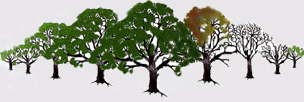
Alternative Eco-Friendly Disposition Options
When
it comes to eco-friendly disposition, there
are a few options to consider, including
natural or green burial, natural organic
reduction (also known as
recomposition or terramation), and
alkaline hydrolysis (also
known as aquamation or resomation).
Natural burial involves interring
or burying the body in a way that supports
the natural processes of decomposition and
land regeneration without the use of harmful
chemicals or materials. Natural
organic reduction (NOR)
uses the process of human composting to
break down the body and create nutrient-rich
soil. Alkaline hydrolysis, on
the other hand, uses water and alkaline
to break down the body into its simplest
elements, which can be safely returned to
the environment. Ultimately,
the choice of which method to use will depend
on personal preferences and beliefs, as
well as any local regulations or requirements.

1.
NATURAL BURIAL
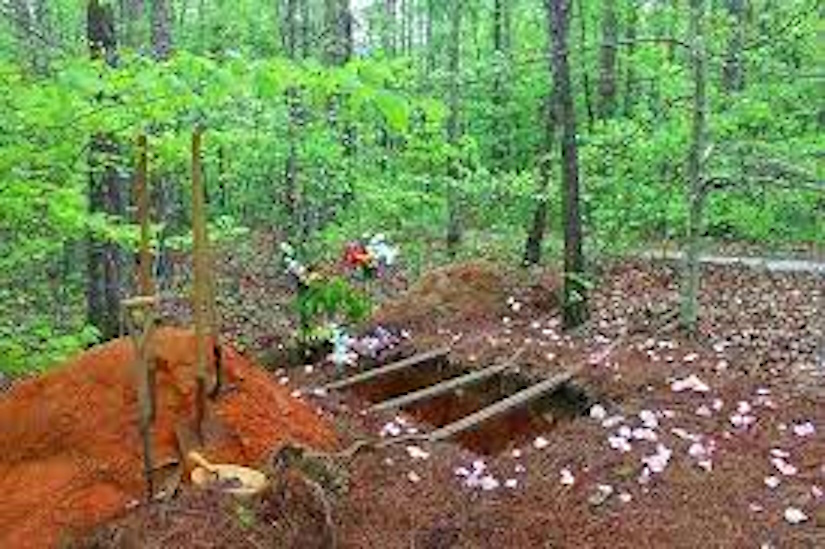 Photo
thanks to BC Green Burial
Photo
thanks to BC Green Burial |
Green
or natural burial is a type of disposition
that seeks to minimize the environmental
impact of conventional burials. This
approach typically involves the use
of biodegradable materials for the
casket, shroud, or urn and the avoidance
of embalming fluids, concrete vaults
and other conventional burial practices
that can be harmful to the environment. The
goal is to promote the return of the
body to the earth in a way that supports
the natural ecosystem and preserves
the land for future generations.
|
| Family
and community participation in such
burials, and even home funerals, can
provide a deeply meaningful and healing
experience during the mourning process. |

WHEN
DID NATURAL BURIAL START?
Natural
burial, while considered an alternative
to traditional Western burial methods and
funerary customs, is in fact an ancient
practice that has been used by many cultures
and religions, including Indigenous, Islamic,
Jewish, and Christian communities. In
these traditions, the body is most often
cared for by the community and laid to rest
in a manner that supports the natural ecosystem.
| For
example, in Jewish tradition, the body
is prepared for burial by a Chevra
Kadisha, a group of individuals
responsible for the sacred act of tahara
(ritual
purification).
The process involves carefully
washing and cleansing the body, reciting
prayers and blessings, and dressing
the deceased in simple white shrouds
(tachrichim);
and done by Sacred Societies. Embalming
is generally not performed in Jewish
tradition, as the body is considered
sacred and should return to the earth
as naturally as possible. |
Chevra
Kadisha
|
In
Muslim tradition, the body is prepared for
burial according to the practices of Islamic
law called Sharia. The
body is washed and cleansed by family members
or individuals with knowledge of the proper
procedure. The body is typically
washed three times using clean water and
sometimes scented with camphor or other
substances. It is then wrapped
in a simple white shroud (kafan)
and laid to rest without embalming.
Both
traditions prioritize simplicity and respect
for the deceased, focusing on honouring
their body and returning it to the earth
as part of the natural cycle of life. Many
cemeteries have designated areas specifically
allocated for Jewish and Muslim burials
to accommodate the religious and cultural
practices of these communities.
|
This
is how dead bodies were cared for
in many countries for thousands of
years — ever since our species
evolved. While natural
burial is not a new practice, it has
gained increased attention in recent
years as part of a global movement
toward connecting with nature and
promoting sustainable ways of living.
Most
green/natural burials allow for the
participation of the family/friends
in laying their beloved in the ground
and filling in the grave. This
encourages a greater recognition of
the reality of the death, a deeper
sense of 'farewell', and a healthier
path of grieving.
|
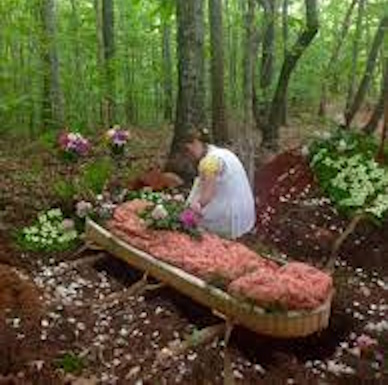 shrouded
body in wicker tray
shrouded
body in wicker tray |
Conservation
burial is a form of natural burial that
aims to protect and preserve natural lands
and ecosystems by interring human remains
in designated conservation areas. It
combines the traditional aspects of burial
with the goal of environmental conservation,
often involving the use of biodegradable
materials and promoting the restoration
of natural habitats. Conservation
burial may be used to revive a clear-cut
area, which then cannot be cut down again
as the land is now considered sacred ground.
.

WHERE
CAN I HAVE A NATURAL BURIAL?

the
first fully natural burial ground
in Canada
|
If
you are interested in having a natural
burial, there are several options
available to you. The Green
Burial Society of Canada maintains
a list of approved natural burial
cemeteries on their website, www.greenburialcanada.ca.
In addition, the website www.greenburialbc.ca
provides resources specific to British
Columbia.
|
While
many conventional cemeteries may not offer
natural burial, there are hybrid cemeteries
that reserve spaces for this type of burial. To determine if your local cemetery
offers this option, consider contacting
them directly to inquire. It's
worth noting that increased demand for natural
burial can encourage cemeteries to offer
this choice in the future.
For
information about natural burial grounds
in the United States, as well as valuable
resources for anyone, visit www.orderofthegooddeath.com.

2.
ALKALINE HYDROLYSIS
| Alkaline
Hydrolysis (AH), also known as aquamation
or resomation, is an alternative
method of final disposition for human
and animal remains. This
process involves placing the body in
a stainless steel chamber with a mixture
of water and alkali, and then subjecting
it to high heat and pressure. Through
a process of chemical reactions, the
body is reduced to bone fragments and
a sterile liquid that can be safely
returned to the environment. This
method is considered a more eco-friendly
alternative to flame cremation or conventional
burial, as it uses less energy and produces
fewer pollutants, resulting in up to
90% energy savings and a much smaller
carbon footprint. |
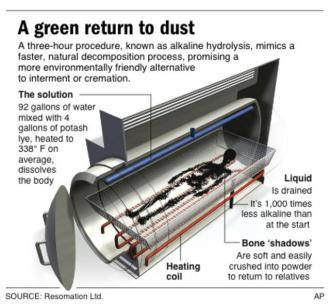 Courtesy of
Confessions of a Funeral Director
Courtesy of
Confessions of a Funeral Director |

WHEN
DID ALKALINE HYDROLYSIS START?
The
basic chemistry behind AH has been known
for over a century, but it was first developed
as a means of disposing of animal carcasses
in the mid-20th century. The
use of AH for human disposition is a more
recent development, with the first human
body being disposed of using this method
in the United States in 1995. Since
then, AH has gained increasing acceptance
as a viable alternative to conventional
burial and cremation in some areas, particularly
as more people seek eco-friendly options
for their final disposition.

LEGALIZATION
& PROVIDERS
AH
is legal in four Canadian provinces and
one territory (Saskatchewan, Ontario, Quebec,
Newfoundland and Labrador, and the Northwest
Territories) and over 20 U.S. states.
AH
is legal for use with pets in all states,
provinces and territories in Canada and
the U.S.A.
It's
important to advocate for AH to be legalized
everywhere. If you agree, there
are a few ways to get involved.
Firstly,
you can sign the existing petitions at Change.org
and https://www.aquamationbc.ca/.
Additionally,
you can write to your local MP and ask them
to support a change in legislation. Go
to https://www.ourcommons.ca/members/en
to find your MP in Canada. Download
a letter template here.
Together, we can help make AH
a reality in BC and other areas around the
world.
|
Eirene.ca
provides contract services in some
provinces and keeps a list of legal
status and existing AH providers by
province and territory. In
addition, below are some in-house
AH providers across Canada as of May
2023:
Gray’s
Funeral Chapel, Prince Albert,
SK
Swift
Current Funeral Home & Crematorium,
Swift Current, SK
Newcastle
Funeral Home Ltd, Newcastle, ON
Kawartha
Aquamation, Peterborough, ON
Pilon
Family Funeral Home, Arnprior,
ON
Funeral
Complex LeSieur, Granby, QC
Central
Funeral Homes, NL
|

Courtesy of
the Smithsonian
|

3.
NATURAL ORGANIC REDUCTION
Natural
organic reduction (NOR),
also known as terramation, recomposition,
or body composting, is an innovative
and environmentally friendly method
of final disposition that converts human
remains into soil. This process
involves placing the body in a mixture
of organic materials, such as wood chips,
straw, and sawdust, which promotes natural
decomposition through microbial activity.
Bones need to be removed and ground,
but are then added back to the NOR soil
(unlike with cremation
and aquamation). Implants
are recovered at the same time, and
maybe reuseable or recycled. Eventually,
the body is transformed into nutrient-rich
soil that can be used for gardening
or land restoration. With
advances in technology and research,
NOR is gaining attention as a sustainable
and eco-friendly alternative to conventional
burial and cremation practices. |
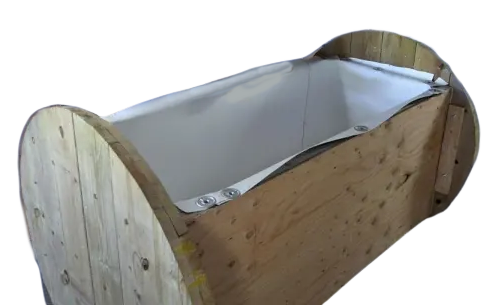 one
variation of a terramation barrel
one
variation of a terramation barrel
Courtesy of Natural Funeral |

WHEN
DID NOR START?
The
NOR method is similar to the composting
process used by farmers to dispose of livestock,
which has been used for centuries.

LEGALIZATION
& PROVIDERS
|
NOR
was first legalized in the state of
Washington in 2019; and, as of February
2023, has since been adopted in Colorado,
Oregon, Vermont, California and New
York.
There
are a few companies in the US that
provide NOR services, including Recompose
(WA), Return
Home (WA),
and Herland
Forest (WA),
Earth
Funerals (WA),
and the Natural
Funeral (CO)
Canadian
residents can currently access human
composting services through Return
Home, which accepts Canadian bodies
at its facility in Washington state
and returns the terramated soil to
the families. The company plans
to open a facility in Canada once
the legislation is approved. |
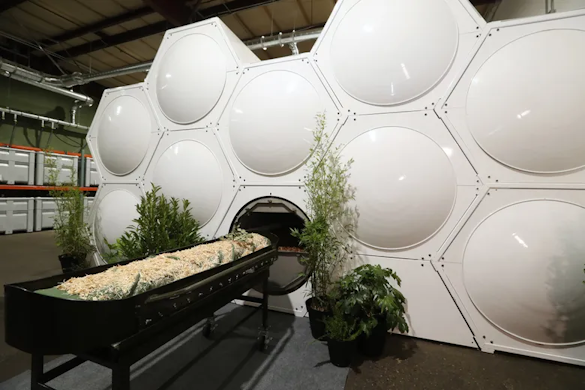 Original
Recompose design by Katrina Spade
Original
Recompose design by Katrina Spade |
| While
the cost of NOR, starting around $5000
USD, combined with the expense of transporting
the body to Return Home from Canada
can be significant, it's important to
consider the ecological benefits and
personal values associated with this
alternative disposition method. |

4.
ORGAN AND BODY DONATION
There
are programs in Canada where you can donate
your body to science, such as the University
of British Columbia's Body Donation Program,
the University
of Alberta's Anatomical Gifts Program,
and the University
of Calgary’s Body Donation Program.
These programs accept whole-body
donations and use them for medical education
and research purposes. In many
cases, the family is responsible for the
cost of transporting the body to the facility,
so that should be considered in planning
the estate/will.
Generally, depending on the location, the
body can be in the program’s care anywhere
from several months up to six years or more.
After that, the remains are
cremated and returned to the university
in preparation for final disposition.
Additionally,
the University
of Quebec at Trois-Rivières (UQTR)
operates a secure site for research in thanatology
(SSRT), which allows scientists from several
fields to carry out work on the decomposition
of human bodies in natural conditions. See
their website
and FAQs
for more information including costs that
the UQTR absorbs, such as body transport
to the site within a maximum radius of 250
km. [Note: their
site is mostly in French.]

Are These the Only Eco-Friendly Disposition Options?
Burial
at sea can be considered eco-friendly if
certain precautions are taken to ensure
that the burial doesn't harm the marine
environment. Both cremated remains
and non-cremated remains can be buried at
sea. Visit the Funeral
Service Association of Canada (FSAC)
for more information on burials at sea. Living
Reef Memorial Canada creates artificial
reefs using the cremated remains of a loved
one. The reefs are made of environmentally
safe, marine-grade concrete and are placed
in the ocean to create new habitats for
marine life.
If
you are interested in exploring additional
eco-friendly options for end-of-life disposition,
including mushroom burial suits and coffins,
Promession's freeze-drying method, and Capsula
Mundi's egg-shaped burial pod, you can find
further information and resources at https://www.orderofthegooddeath.com/resources/green-death-technology/.

ACCESSING
ECO-CONSCIOUS PROVIDERS
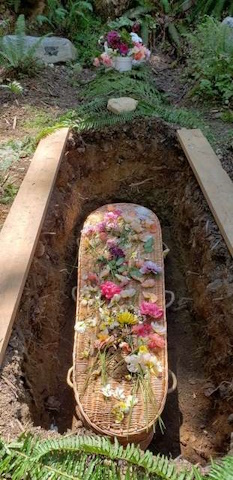
Thanks to Green Burial BC |
While
a comprehensive directory of green
funeral providers does not exist,
the links above offer helpful questions
to ask when searching for a provider
in your area. Also,the
Green
Burial Society of Canada has an
initial directory of certified green
burial grounds in Canada. Be
wary of 'green washing or sheen' —
"is
when a company promotes itself, its
operations, or its products as being
more environmentally oriented than
they really are. Also
known as “green sheen,”
greenwashing is an attempt to deceive
consumers by using deceptive advertising
or unfounded claims about the environmental
sensitivity or benefits of a product
or service.""
(quote from
GBSC)
It's
important to start looking for a provider
early while you and your loved ones
are still healthy and ask as many
questions as you need to make an informed
decision. CINDEA
is aware of some funeral providers
who are eco-friendly – contact
us.
|
To
start your search, you can also reach out
to a local death doula or community deathcare
advocate and ask if they are aware of any
eco-conscious funeral providers or products.
Check out the End
of Life Doula Association of Canada
or Death
Doula Network International to get started.
Additionally,
join the CINDEA-sponsored CAN-ADWEN
or the Community
Deathcare Canada Facebook group to ask
questions and connect with others.

THE
DANGER OF SPREADING 'ASHES'
|
Note: cremation and aquamation remains are not actually 'ashes', but ground bone.
Most
people assume that spreading ashes
is either nutritional for the soil
– or at least of no harm to it.
In fact, untreated cremation ashes
disrupt the sensitive chemical and
biological balance of soils (particularly
the pH level) that will cause
lasting damage to soil and plant health
– even when spreading widely.
Although ashes are not
healthy for water, they tend to spread
so widely that they are not harmful.
This does, however, raise
questions about cremains being used
to build new coral reefs, at least in the long term.
Burying
an ash-urn is also not good for the
soil, as it will eventually break
down. There are some companies
developing an organic compound that
will adjust the chemical balance of
the ashes, making them safe for spreading
or burying. However, this
science is very new; and we don’t
have proof that it works, but you
may want to try it out – ex.
https://letyourlovegrow.com/.
|
|
Aquamation
ashes are sterile, but toxic to plants
if all spread in one area. On
the other hand, they can be benefical
to the plants mixed with plenty of
potting soil. Your
Aquamation provider can provide you
with guidance as to the best mixture
for your area. Aquamation produces more remains ('ashes') than cremation – which are white and as fine as powdered sugar. If scattered on water, they will not sink – but spread out in a fan-shape. Therefore, they should be scattered far away from the shore.
In
Canada in general, there are no rules against
spreading ashes. Quebec does
have laws (Funeral Operations
Act, Article 71,) against spreading
ashes where it might be considered disrespectful
to the land or person. If you
are considering spreading ashes in a park,
graveyard, or any public area, you are responsible
to contact the authorities to inquire if
it is acceptable.
Note:

Planet-Friendly Home Funerals
| A
home funeral can be a cost-effective
and ecologically conscious option that
takes place before the disposition method.
It allows you to care for
the body and say goodbye in a comfortable
and intimate setting, and begins a healthy
grieving process. It is
deeply consistent with ecological forms
of disposition, and totally appropriate
before green/natural burial, Aquamation,
or Recomposition/Terramaton. Learn
more about home funerals at Post-Death
Care and Home Funerals/ Community Deathcare. |
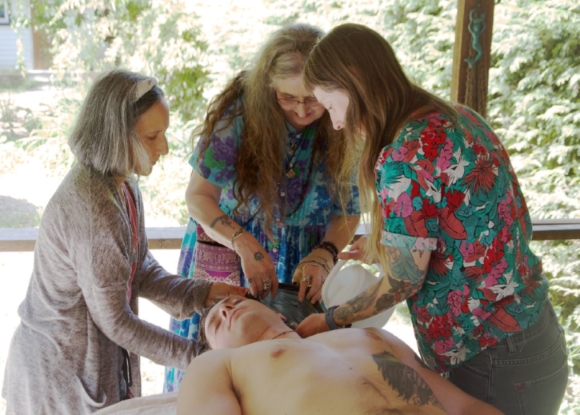 home
funeral training
home
funeral training |

Pet Disposition
|
In
Canada, there are several options
for the final disposition of a beloved
pet's remains:
Burial
at home: In most cases, it is
legal to bury a pet on private property
in Canada, as long as they are buried
at a sufficient depth (usually
at least 3 feet). However,
it is important to check with your
municipality's bylaws to ensure that
there are no restrictions or regulations
in place.
Burial
at a pet cemetery: There are several
pet cemeteries across Canada that
offer burial services for pets, as
well as options for cremation and
memorialization.
Cremation:
Many pet owners choose to have their
pet's remains cremated, either through
a private cremation or a communal
one. Some pet cremation
services also offer options for memorialization,
such as urns, jewellery, and other
keepsakes.
|
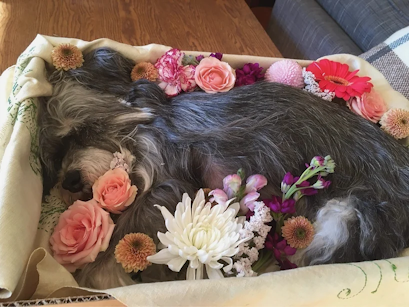 Courtesy of
Daisy Deathcare
Courtesy of
Daisy Deathcare |
Alkaline
hydrolysis (AH): AH is legal for
pets in all states, provinces and territories
in Canada and the U.S.A. The
resulting remains can be kept, scattered,
or buried.
It
is important to note that different regions
and municipalities may have different regulations
and bylaws regarding pet burial and cremation.
It is recommended to check with
local authorities or a pet funeral service
for guidance on the best options available
in your area.
Similarly
to our human loved ones, pets can be kept
at home for a pet wake, funeral, or memorial
before the disposition takes place. Search
for local pet funeral service providers
or visit Daisy
Deathcare for information and resources
on what you can do when a pet dies.
Check
for more options as they come available
on CINDEA’s Post-death
Page.
|






